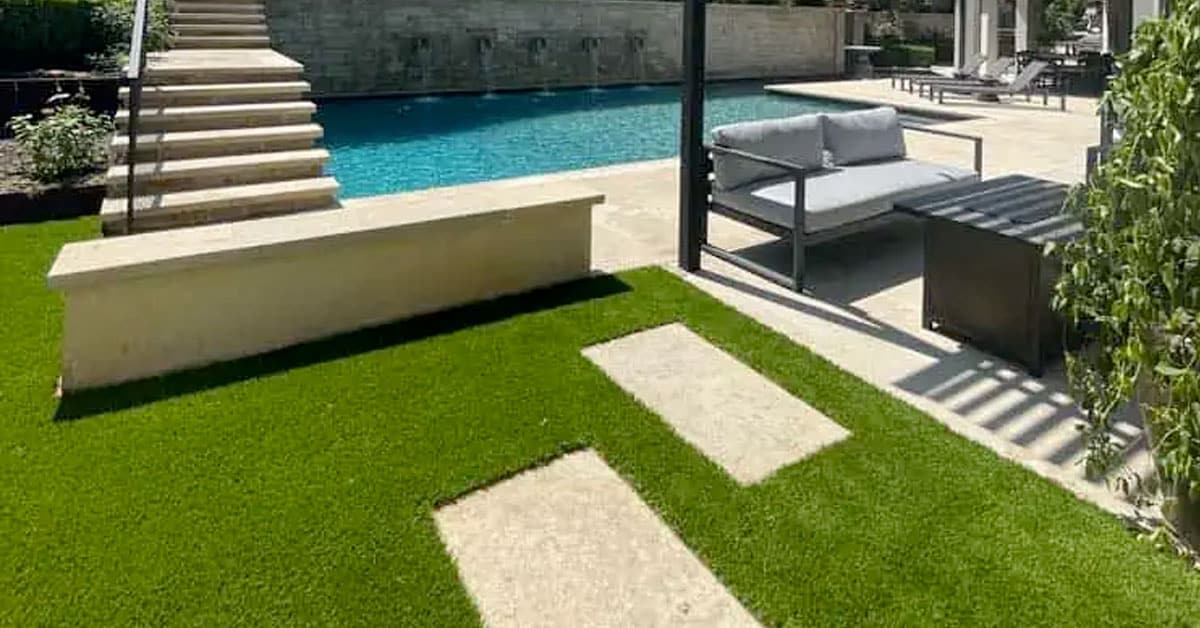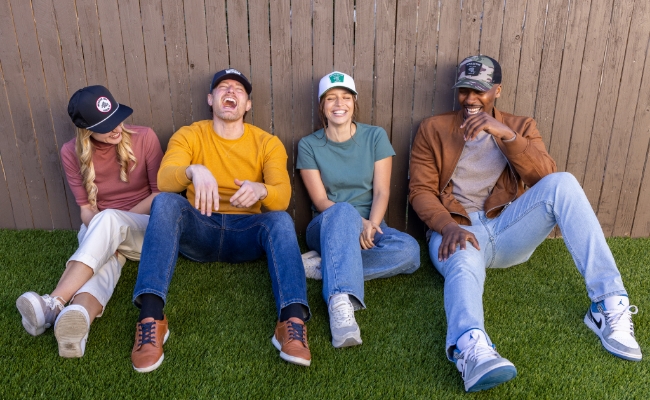The Secret to Saving Water in Drought-Stricken Central Texas

Why Artificial Turf is the Sustainable Lawn Solution for Central Texas
The American West is running out of water. With a booming population and extended drought conditions, states like Texas and California face a major water crisis and saving water in new and creative ways. No where is this more evident than in Central Texas, which relies on reservoirs like Lake Travis and Lake Buchanan to supply the water needs of cities like Austin and San Antonio. As water levels in these lakes continue to drop, strict water restrictions have become the new normal for the region. Homeowners are being asked to drastically cut back on all non-essential water use, especially for landscaping and lawns. This is why artificial turf has emerged as the sustainable lawn solution for Central Texas. Artificial grass requires no irrigation, allowing homeowners to conserve water while still enjoying lush, green lawns. In this article, we’ll explore the benefits of artificial turf and how it can help communities like Austin withstand the drought while preserving essential water supplies.
High Water Usage of Natural Grass
Natural grass lawns require significant amounts of water to stay green and lush in Central Texas. On average, grass needs about 1 inch of water per week from irrigation during the hot summer months. For a typical suburban lawn of around 5,000 square feet, that equates to over 12,500 gallons of water per week just for irrigation in the peak of summer. Over an entire year, a lawn of that size would use around 650,000 gallons of water.
With the climate in Central Texas becoming increasingly hot and dry during summer, natural grass relies heavily on supplemental irrigation from sprinkler systems to survive. Water restrictions often go into effect during drought conditions, limiting when and how much homeowners are allowed to water their lawns. Even without restrictions, the amount of water needed to keep grass green puts a major strain on limited water resources in Texas.
Low Water Needs of Artificial Turf
Artificial turf is designed to mimic the look and feel of natural grass while requiring a fraction of the water. Once installed properly, artificial lawns need no irrigation, even in the hot and dry Texas climate.
The synthetic blades of artificial grass are made from polyethylene or polypropylene. They are durable and retain their color even with no water. The materials used allow airflow and drainage so no puddling occurs. No water is needed to keep artificial turf green, unlike real grass which requires frequent watering.
With artificial lawns, there’s no need to worry about water restrictions. Homeowners can conserve water for other uses while still enjoying a lush, attractive lawn. The low water requirements make artificial turf ideal for drought-prone areas like Central Texas.
Switching to a synthetic turf lawn is one of the most effective ways homeowners in the region can reduce outdoor water usage. With artificial grass, you can have an enviably green yard while doing your part to use water wisely.
Water Restrictions in Texas
Many parts of Texas have been under some form of water restrictions for years now due to drought and growing populations putting a strain on water supplies.
Major Texas cities like Houston, Dallas, San Antonio and Austin have all had to implement policies towards saving water, especially for landscape irrigation. For example, the city of Austin has been under Stage 2 drought restrictions since 2014, which prohibits landscape watering more than 1 time per week.
The Edward Aquifer that provides water to San Antonio has experienced significant strain, resulting in Stage 2 pumping restrictions being implemented frequently. These pumping limits help preserve aquifer levels and avoid depleting this vital water source.
With climate change expected to result in hotter and drier conditions throughout Texas, most experts believe that the entire state will need to get accustomed to some form of watering restrictions. Homeowners and businesses that want lush, green landscapes will need to strongly consider water-saving options like artificial grass and synthetic turf.
Benefits of Artificial Turf
Artificial turf provides a number of benefits over natural grass that make it an attractive option for homeowners and businesses in Central Texas.
- Always Green Look: One of the main advantages of artificial turf is that it maintains a lush, green appearance year-round regardless of weather or water restrictions. Natural grass can turn brown during hot, dry periods without adequate irrigation. With artificial grass, you’ll always have an attractive, flawless lawn.
- Usability: Artificial turf allows for immediate use after installation. There is no need to wait for grass to grow in or recover from heavy activity. Synthetic grass can be enjoyed right away with no downtime. Families with children or pets will appreciate this benefit.
- Low Maintenance: While natural grass requires regular mowing, watering, fertilizing and treatment for weeds and pests, artificial turf needs little ongoing care. Other than occasional rinsing to clear dust and debris, artificial lawns are virtually maintenance free. They don’t need to be mowed, irrigated or treated with chemicals and pesticides.
Artificial Turf Installation
Here at Waterloo Turf, we handle the entire artificial grass installation process for you. Our team of experienced installers will make sure your new synthetic lawn is perfectly fitted and seamlessly installed.
First, we prepare the area by removing any existing grass or vegetation, leveling the ground, compacting the soil and installing proper drainage. Proper drainage is crucial to prevent water pooling under your turf.
Next, we install the turf fabric over the prepared base and securing it in place. The turf fabric provides a barrier between the turf and ground and allows proper drainage.
The artificial grass is then meticulously measured, cut and secured over the fabric. We use specialty turf adhesives to seamlessly join any seams and edges. The infill material is installed in layers and brushed thoroughly into the blade structure of the turf to support the blades in an upright position.
We also create a clean edge around your new turf using timber, concrete or steel edging solutions. This gives your turf installation a sharp, professional finish.
Our turf installations come with a minimum 8-10 year warranty and a satisfaction guarantee. Contact us today to schedule a free consultation!
Types of Artificial Grass
There are many different types of artificial grass to choose from based on your needs.
Pet Turf
Pet turf is designed specifically for houses with dogs. It is extremely durable and designed to stand up to pet urine. The fibers are antimicrobial, which prevents odors and bacteria growth. Some pet turf has a porous backing to allow urine to drain through. This is ideal if you want to let your dog relieve themselves in your backyard without ruining the grass.
Putting Greens
If you’re a golf enthusiast, artificial putting greens are a great option. The turf closely mimics the texture, speed, and appearance of natural grass on putting greens. You can practice your short game any time without having to leave home. Putting greens come in various sizes to fit your backyard.
Playground Turf
For backyard playgrounds, playground turf is soft, durable, and slip-resistant. It cushions falls to help prevent injuries. Playground turf comes in vibrant colors that kids find appealing.
Landscaping Turf
The most common type of artificial grass is landscaping turf for yards and lawns. It looks just like lush natural grass. Landscaping turf is available in various blade lengths and widths to match your preferences. The pile height ranges from 15mm up to 50mm for a very plush lawn.
There are many artificial grass options to create the perfect lawn or backyard putting green. High-quality turf installed properly can last 15-20 years. Artificial grass gives you the look of a pristine lawn with none of the water usage.
Saving Water, Saving Money
Installing artificial turf can lead to significant cost savings over time compared to maintaining a traditional grass lawn. After the initial investment, which can range from $6-$13 per square foot installed, the ongoing costs are minimal. There’s no need for regular mowing, fertilizing, aerating, dethatching, or pest control. The turf also doesn’t require irrigation, which saves a tremendous amount of water.
Over a 10 year period, it’s estimated that a homeowner can save $3,000-$4,000 in lawn maintenance costs with artificial turf compared to natural grass. The return on investment ranges from 2-10 years depending on the size of the lawn. Artificial grass is an especially smart investment for homeowners with large yards over 1,000 sq ft while saving water at the same time. The larger the lawn, the more dramatic the cost savings will be over time.
Many homeowners find the money they save on maintenance pays for their artificial turf within 5 years or less. The turf also increases the value of a home by 4.9%-10% on average, meaning owners can recoup the costs when it comes time to sell. For those looking to save money and time on lawn care, artificial grass is an excellent landscaping investment.
Environmental Benefits
Installing artificial turf provides numerous benefits for the environment. Unlike natural grass which requires substantial watering, fertilizers, pesticides and mowing, artificial turf has minimal environmental impact once installed.
Artificial grass does not require watering, which conserves precious water in drought-prone areas like Central Texas. Homeowners with artificial lawns can reduce outdoor water usage by up to 50% or more. Multiply these savings by the thousands of homes in the area, and the positive impact on water conservation is significant.
In addition, artificial turf does not require the use of fertilizers, pesticides or gas-powered lawn mowers. This eliminates runoff that pollutes local streams and rivers. Artificial grass also reduces air pollution from lawn mowers and other maintenance equipment.
Furthermore, artificial turf provides a durable and lush lawn without destroying natural habitats. Traditional lawns displace native plants, trees and wildlife, while artificial grass co-exists with nature.
By installing low-maintenance artificial turf, Central Texas homeowners can enjoy a beautiful lawn while conserving water, reducing pollution and protecting the local environment. The positive ecological effects multiply across the community. For those seeking an environmentally friendly landscape, artificial grass is an excellent solution.
Conclusion
Installing artificial turf is one of the best ways for homeowners and businesses to reduce outdoor water usage in Central Texas. With frequent droughts and watering restrictions, natural grass lawns can require a significant amount of water to maintain their appearance. Artificial grass only needs occasional rinsing to look great year-round.
Switching to a synthetic turf lawn provides immediate water savings. There’s no need for frequent watering, even during the hot and dry Texas summers. Artificial turf thrives without any irrigation after installation. Homeowners can turn off their sprinkler systems entirely once fake grass is in place. These substantial water savings quickly add up for families and organizations in the region.
Beyond the direct water reductions, artificial turf also has indirect environmental benefits. Natural grass lawns can leach fertilizers and pesticides into the local watershed when irrigated or flooded with rainwater. Fake grass does not require these chemical treatments. Runoff from synthetic lawns is much cleaner as a result. Anything that improves water quality is a bonus in Central Texas.
For homeowners and businesses looking to conserve water, artificial turf is a perfect solution. The synthetic materials provide a lush, beautiful, low maintenance lawn without wasting water. As Central Texas continues to grow, switching from natural grass to artificial turf can help the region save water and preserve the environment for the future.
Back


